Optical Investigation of Sparks to Improve Ignition Simulation Models in Spark-Ignition Engines
Abstract
:1. Introduction
2. Experimental Investigation
2.1. Testbed
2.2. Measurement Techniques and Data Processing
3. Simulation Setup
4. Results and Discussion
4.1. Optical Plasma Parameters
4.2. Velocity Multiplication Factor—Incorporation and Calibration
4.3. Heat Transfer by 2-Way Coupling of Plasma Particles in CADIM
5. Conclusions
Author Contributions
Funding
Data Availability Statement
Acknowledgments
Conflicts of Interest
Abbreviations
| BOS | Background-Oriented Schlieren |
| ICE | Internal Combustion Engine |
| CFD | Computational Fluid Dynamics |
| DPIK | Discrete Particle Ignition Kernel |
| AKTIM | Arc and Kernel Tracking Ignition Model |
| SI | Spark Ignition |
| SBOS | Speckle Background-Oriented Schlieren |
| CMOS | Complementary Metal-oxide-semiconductor |
| FCD | Fast Checkerboard Demodulation |
| DIC | Digital Image Correlation |
| FPBOS | Forward Projected Background-Oriented Schlieren |
| CADIM | Curved Arc Diffusion Ignition Model |
| VM | Velocity Multiplier |
| TWP | Two Way Particles |
| RANS | Reynolds-Averaged Navier–Stokes |
| Symbols | |
| Density | |
| S | Displacement in the plane of background |
| Es | Available electrical energy on the secondary circuit |
| Rs | Secondary circuit’s resistance |
| Ls | Secondary circuit’s inductance |
| Ebd | Absorbed electrical energy |
| Vbd | Breakdown voltage |
| die | Inter-electrode distance |
| is | Secondary current |
| Vgc | Voltage in the gas column |
| lspk | Spark length |
| p | Pressure |
| dis | Discharge coefficient |
| Vie | Inter-electrode voltage |
| Vcf | Cathode voltage fall |
| Vaf | Anode voltage fall |
| Ignition delay time | |
| dYp | Instantaneous change in ignition precursor |
| Q | Rate of heat transfer from the spark to the surrounding |
| A | Heat transfer surface area |
| hc | Convective heat transfer coefficient |
| ΔT | Temperature difference between the spark and its surroundings |
| V | Velocity |
References
- Schumacher, M.; Russwurm, T.; Wensing, M. Pre-Chamber Ignition System for Homogeneous Lean Combustion Processes with Active Fuelling by Volatile Fuel Components; Expert-Verlag: Berlin, Germany, 2018. [Google Scholar] [CrossRef]
- Zhu, S.; Akehurst, S.; Lewis, A.; Yuan, H. A review of the pre-chamber ignition system applied on future low-carbon spark ignition engines. Renew. Sustain. Energy Rev. 2022, 154, 111872. [Google Scholar] [CrossRef]
- Schaefer, L. Modeling and Simulation of Spark Ignition in Turbocharged Direct Injection Spark Ignition Engines; Verlag Dr.Hut: Munich, Germany, 2016. [Google Scholar]
- Tan, Z.; Reitz, R.D. An ignition and combustion model based on the level-set method for spark ignition engine multidimensional modeling. Combust. Flame 2006, 145, 1–15. [Google Scholar] [CrossRef]
- Duclos, J.; Colin, O. Arc and Kernel Tracking Ignition Model for 3D Spark-Ignition Engine Calculations. In Proceedings of the The Fifth International Symposium on Diagnostics and Modeling of Combustion in Internal Combustion Engines (COMODIA 2001), Nagoya, Japan, 1–4 July 2001; pp. 343–350. [Google Scholar]
- Dahms, R.; Fansler, T.; Drake, M.; Kuo, T.W.; Lippert, A.; Peters, N. Modeling ignition phenomena in spray-guided spark-ignited engines. Proc. Combust. Inst. 2009, 32, 2743–2750. [Google Scholar] [CrossRef]
- Kim, J.; Scarcelli, R.; Karpatne, A.; Subramaniam, V.; Breden, D.; Raja, L.L.; Zhai, J.; Lee, S.Y. Numerical investigation of the spark discharge process in a crossflow. J. Phys. D Appl. Phys. 2022, 55, 495502. [Google Scholar] [CrossRef]
- AVL List GmbH. FIRE™ M User Manual: R2023.2; AVL List GmbH: Graz, Austria, 2023. [Google Scholar]
- Schneider, A.; Leick, P.; Hettinger, A.; Rottengruber, H. Experimental Studies on Spark Stability in an Optical Combustion Vessel under Flowing Conditions; Springer Vieweg: Wiesbaden, Germany, 2016. [Google Scholar] [CrossRef]
- Kim, W.; Bae, C.; Michler, T.; Toedter, O.; Koch, T. Spatio-Temporally Resolved Emission Spectroscopy of Inductive Spark Ignition in Atmospheric Air Condition; Expert-Verlag: Berlin, Germany, 2018. [Google Scholar] [CrossRef]
- Michler, T.; Toedter, O.; Koch, T. Measurement of temporal and spatial resolved rotational temperature in ignition sparks at atmospheric pressure. Automot. Engine Technol. 2020, 5, 57–70. [Google Scholar] [CrossRef]
- Verhoeven, D. Interferometric spark calorimetry. Exp. Fluids 2000, 28, 86–92. [Google Scholar] [CrossRef]
- Michalski, Q.; Benito Parejo, C.J.; Claverie, A.; Sotton, J.; Bellenoue, M. An application of Speckle-based Background-Oriented Schlieren for optical calorimetry. Exp. Therm. Fluid Sci. 2018, 91, 470–478. [Google Scholar] [CrossRef]
- Grüninger, M.; Toedter, O.; Koch, T. Optical Analysis of Ignition Sparks and Inflammation Using Background-Oriented Schlieren Technique. Energies 2024, 17, 1274. [Google Scholar] [CrossRef]
- Kottakalam, S.; Rottenkolber, G.; Trapp, C. Forward projected Background-Oriented Schlieren for study of sparks in internal combustion engines. In Proceedings of the International Symposium on the Application of Laser and Imaging Techniques to Fluid Mechanics, Lisbon, Portugal, 8–11 July 2024; pp. 1–16. [Google Scholar] [CrossRef]
- Leopold, F.; Jagusinski, F.; Demeautis, C.; Ota, M.; Klatt, D. Increase of Accuray for Cbos by Background Projection. In Proceedings of the 15th International Symposium on Flow Visualization, Minsk, Belarus, 25–28 June 2012. [Google Scholar]
- Sugisaki, H.; Lee, C.; Ozawa, Y.; Nakai, K.; Saito, Y.; Nonomura, T.; Asai, K.; Matsuda, Y. Single-pixel correlation applied to Background-Oriented Schlieren measurement. Exp. Fluids 2022, 63, 36. [Google Scholar] [CrossRef]
- Kottakalam, S.; Alkezbari, A.; Rottenkolber, G.; Trapp, C. Developing Optical measurement techniques for improving ignition simulation models. In Proceedings of the 14th International ERCOFTAC Symposium on Engineering Turbulence Modelling and Measurements, Barcelona, Spain, 6–8 September 2023. [Google Scholar]
- Maly, R. Spark Ignition: Its Physics and Effect on the Internal Combustion Engine. In Fuel Economy in Road Vehicles Powered by Spark Ignition Engines; Plenum Press: Boston, MA, USA, 1984; pp. 91–148. [Google Scholar] [CrossRef]
- Dalziel, S.; Hughes, G.; Sutherland, B. Whole-field density measurements by ‘synthetic Schlieren’. Exp. Fluids 2000, 28, 322–335. [Google Scholar] [CrossRef]
- Raffel, M. Background-Oriented Schlieren (BOS) Techniques. Exp. Fluids 2015, 56, 60. [Google Scholar]
- Venkatakrishnan, L.; Meier, G. Density Measurements Using the Background-Oriented Schlieren Technique. Exp. Fluids 2004, 37, 237–247. [Google Scholar] [CrossRef]
- Wildeman, S. Real-time quantitative Schlieren imaging by fast Fourier demodulation of a checkered backdrop. Exp. Fluids 2018, 59, 97. [Google Scholar] [CrossRef]
- Shimazaki, T.; Ichihara, S.; Tagawa, Y. Background-Oriented Schlieren technique with fast Fourier demodulation for measuring large density-gradient fields of fluids. Exp. Therm. Fluid Sci. 2022, 134, 110598. [Google Scholar] [CrossRef]
- Yamagishi, M.; Ichihara, S.; Tagawa, Y.; Ota, M. Small-Scale BOS Measurement Using Background Projection. In Proceedings of the International Symposium on the Application of Laser and Imaging Techniques to Fluid Mechanics, Lisbon, Portugal, 8–11 July 2024; pp. 1–11. [Google Scholar] [CrossRef]
- Kim, J.; Anderson, R.W. Spark Anemometry of Bulk Gas Velocity at the Plug Gap of a Firing Engine. SAE Trans. 1995, 104, 2256–2266. [Google Scholar]
- Heywood, J.B. Internal Combustion Engine Fundamentals, 2nd ed.; McGrawHill Book Company: New York, NY, USA, 1988. [Google Scholar]
- Francois, L.; Castagne, M.; Dumas, J.; Henriot, S. Development and Validation of a Knock Model in Spark Ignition Engines Using a CFD Code; SAE International: Warrendale PA, USA, 2002. [Google Scholar] [CrossRef]
- Khabari, A.; Zenouzi, M.; O’Connor, T.; Rodas, A. Natural and Forced Convective Heat Transfer Analysis of Nanostructured Surface. Lect. Notes Eng. Comput. Sci. 2014, 1, 317–319. [Google Scholar]
- Tambasco, C.; Li, D.; Hall, M.; Matthews, R. Spark Ignition Discharge Characteristics under Quiescent Conditions and with Convective Flows; SAE International: Warrendale PA, USA, 2021. [Google Scholar] [CrossRef]





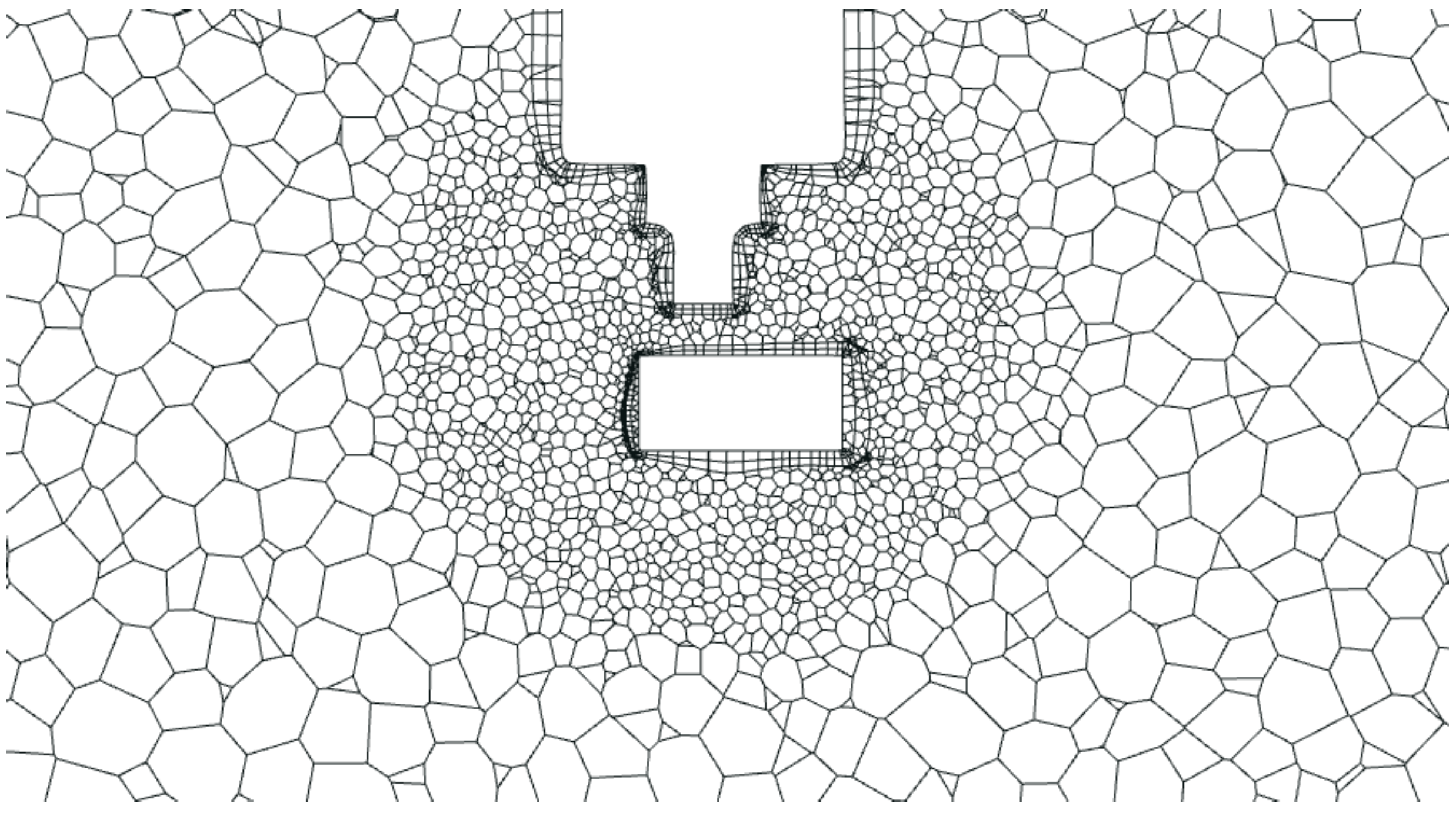

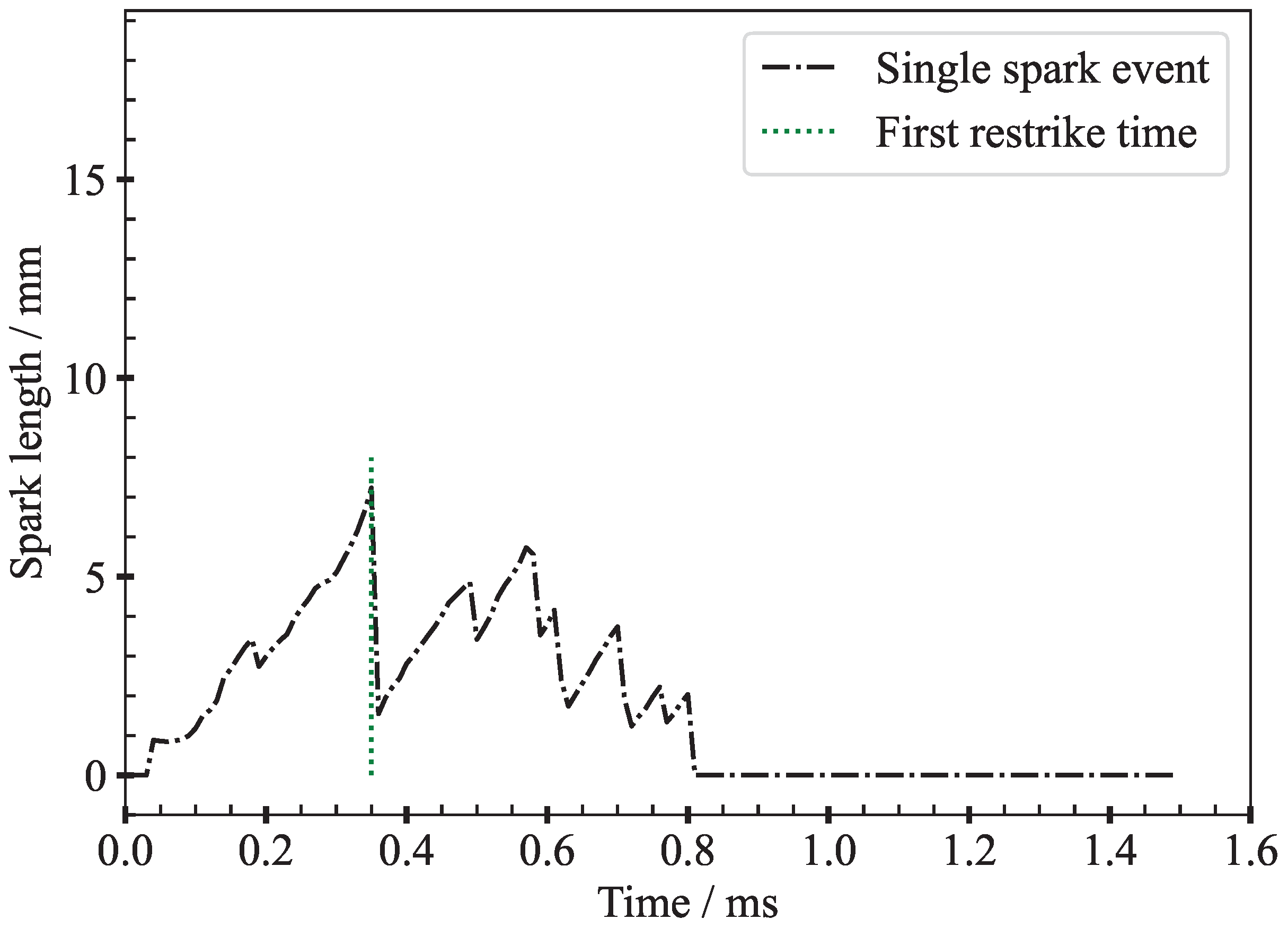
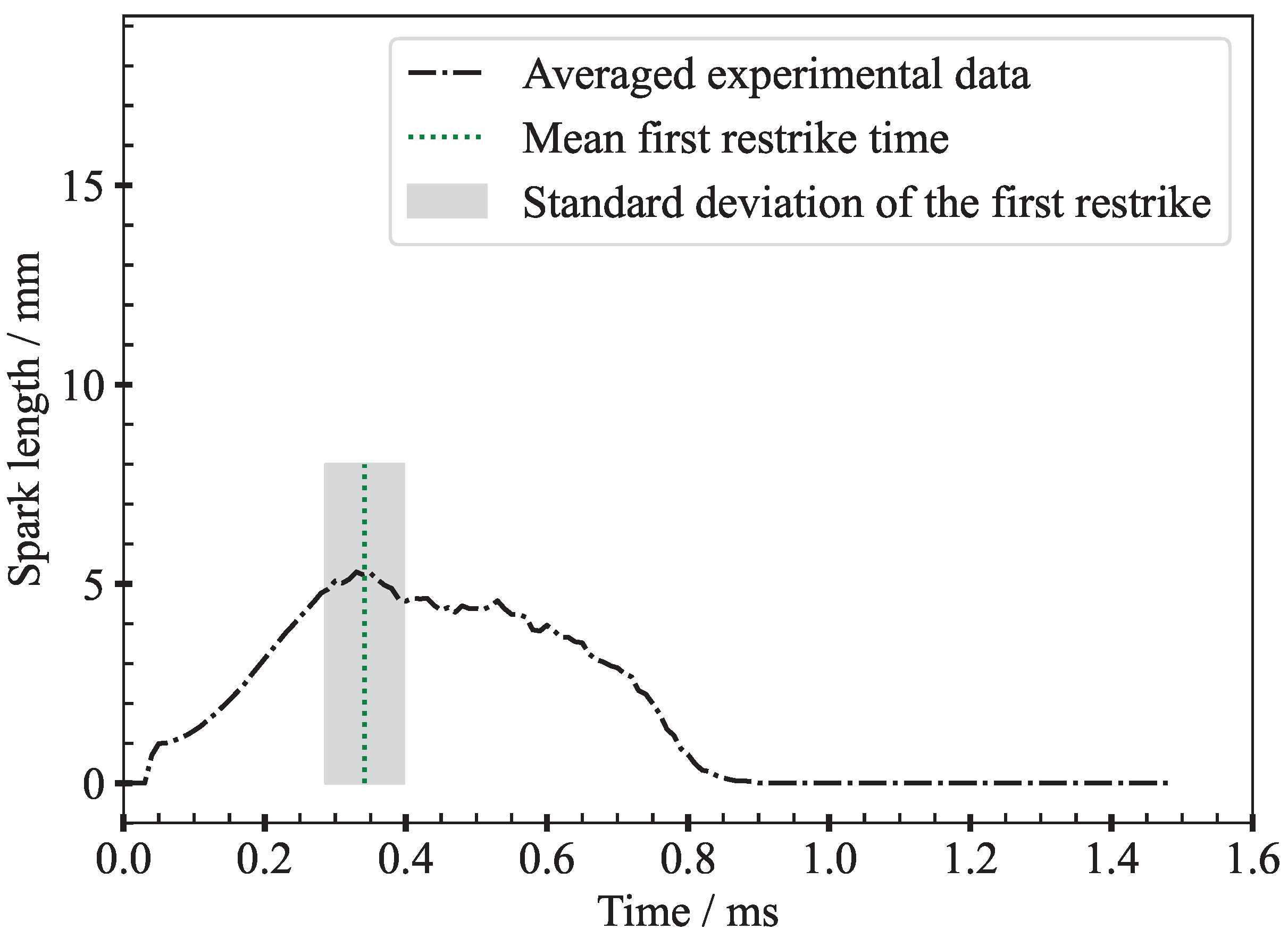

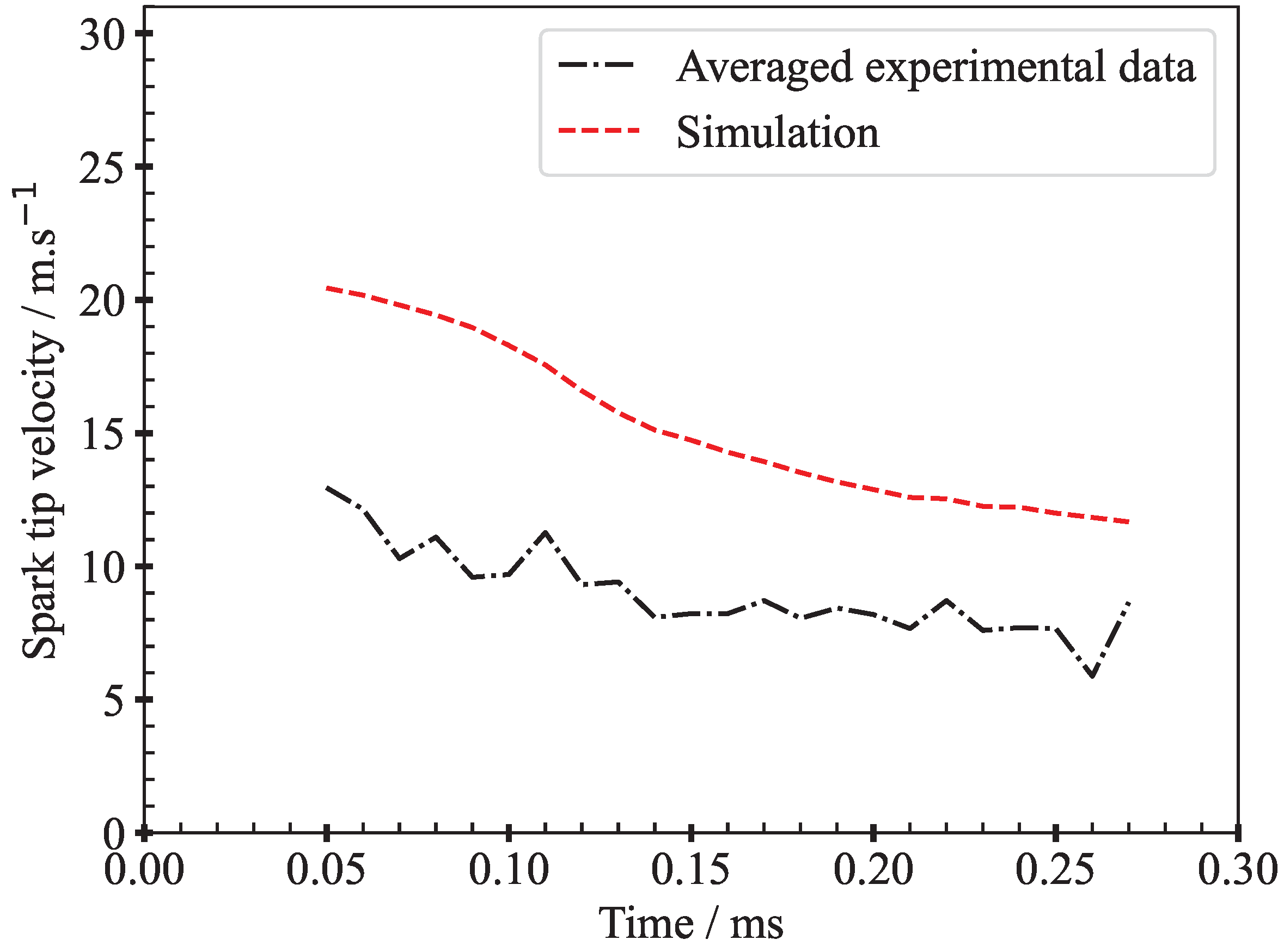


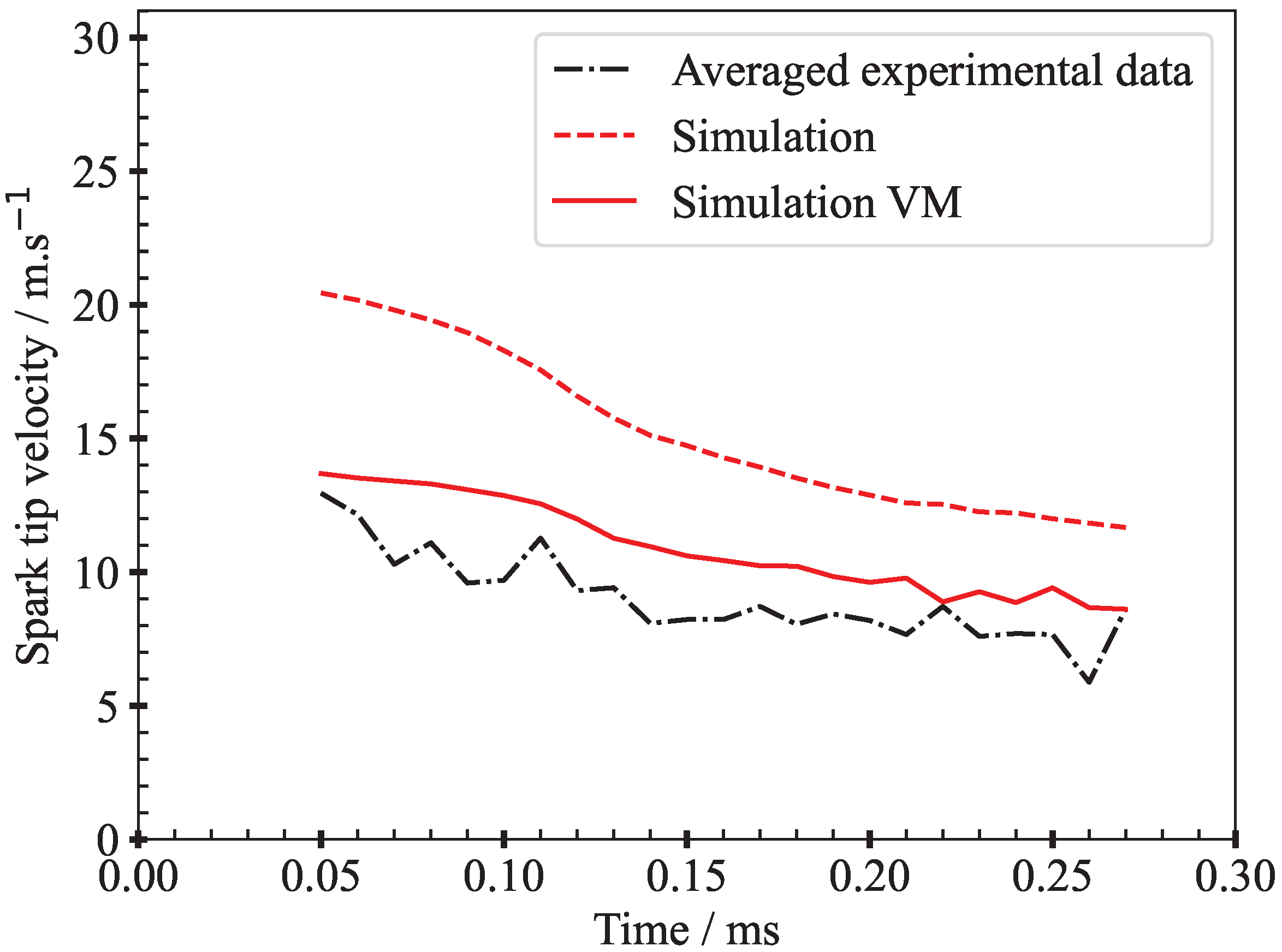

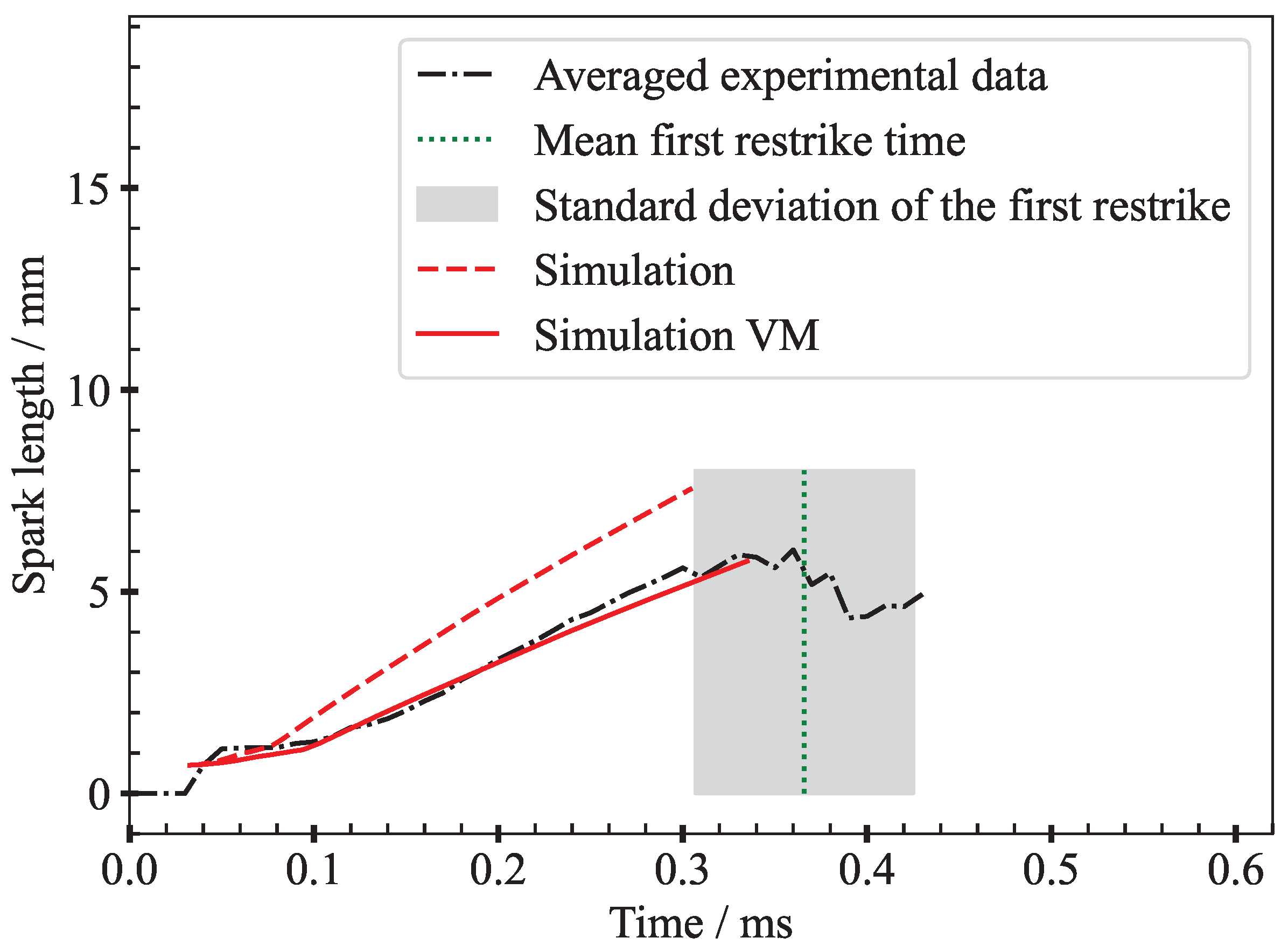


| Absolute Pressure (bar) | Flow Velocity (m/s) |
|---|---|
| 6 | 10 |
| 6 | 15 |
| 11 | 15 |
Disclaimer/Publisher’s Note: The statements, opinions and data contained in all publications are solely those of the individual author(s) and contributor(s) and not of MDPI and/or the editor(s). MDPI and/or the editor(s) disclaim responsibility for any injury to people or property resulting from any ideas, methods, instructions or products referred to in the content. |
© 2024 by the authors. Licensee MDPI, Basel, Switzerland. This article is an open access article distributed under the terms and conditions of the Creative Commons Attribution (CC BY) license (https://creativecommons.org/licenses/by/4.0/).
Share and Cite
Kottakalam, S.; Alkezbari, A.A.; Rottenkolber, G.; Trapp, C. Optical Investigation of Sparks to Improve Ignition Simulation Models in Spark-Ignition Engines. Energies 2024, 17, 4640. https://doi.org/10.3390/en17184640
Kottakalam S, Alkezbari AA, Rottenkolber G, Trapp C. Optical Investigation of Sparks to Improve Ignition Simulation Models in Spark-Ignition Engines. Energies. 2024; 17(18):4640. https://doi.org/10.3390/en17184640
Chicago/Turabian StyleKottakalam, Saraschandran, Ahmad Anas Alkezbari, Gregor Rottenkolber, and Christian Trapp. 2024. "Optical Investigation of Sparks to Improve Ignition Simulation Models in Spark-Ignition Engines" Energies 17, no. 18: 4640. https://doi.org/10.3390/en17184640
APA StyleKottakalam, S., Alkezbari, A. A., Rottenkolber, G., & Trapp, C. (2024). Optical Investigation of Sparks to Improve Ignition Simulation Models in Spark-Ignition Engines. Energies, 17(18), 4640. https://doi.org/10.3390/en17184640







